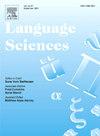The etymology of opaque place names based on a cognitive and interdisciplinary method
IF 1.1
2区 文学
Q2 EDUCATION & EDUCATIONAL RESEARCH
引用次数: 0
Abstract
The method to study the etymology of opaque place names (we don't know what they mean) has been the same since the nineteenth century and, according to our research, it presents some weak phases of research process. For that reason, we have designed and experimented with a different methodology, with a cognitive and geographical approach. The initial objective was not to know the language in which the opaque toponyms were created, but what they referred to.
Based on the principles of corpus linguistics, a corpus of 180 Pyrenean population toponyms was first constructed, along with quotations of them in medieval documents. In total there were 464 toponyms in the corpus. Next, each toponym was associated with its morphological (all possible segmentations of the place name) and geographic variables (the elements of the landscape where the settlement is located). Finally, the statistical filters made it possible to relate the 1179 segments of the opaque toponyms of the corpus to 133 elements of the landscape. Thanks to this, it was possible to reconstruct five prototypical (model from which there can be variations) old cognates (they served to form words in European languages from different affiliations) which show great antiquity because they refer to basic and versatile concepts: ‘something that is cut’, or ‘does not move’, or ‘is on top’, etc. Therefore, this linguistic archaeology research reveals that in the opaque European toponyms, considered linguistic fossils due to their permanence over time, prehistoric cognates from a common old language, possibly Proto-Indo-European, could endure.
基于认知和跨学科方法的不透明地名词源学
自 19 世纪以来,研究不透明地名(我们不知道其含义)词源的方法一直沿用至今,根据我们的研究,这种方法在研究过程中存在一些薄弱环节。因此,我们设计并尝试了一种不同的方法,采用认知和地理方法。根据语料库语言学的原则,我们首先建立了一个包含 180 个比利牛斯人口地名的语料库,并在中世纪文献中引用了这些地名。语料库中共有 464 个地名。然后,将每个地名与其形态变量(地名的所有可能分段)和地理变量(聚落所在的景观要素)联系起来。最后,统计筛选器将语料库中不透明地名的 1179 个分段与 133 个景观要素联系起来。因此,有可能重建五个原型(可以从中产生变化的模型)古老同义词(它们在不同隶属关系的欧洲语言中构成词语),这些同义词显示出极大的古老性,因为它们指的是基本和通用的概念:"被切割的东西 "或 "不动 "或 "在上面 "等。因此,这项语言考古学研究揭示,在不透明的欧洲地名(因其随着时间的推移而永恒存在而被视为语言化石)中,来自一种共同的古老语言(可能是原印欧语)的史前同源词可能持续存在。
本文章由计算机程序翻译,如有差异,请以英文原文为准。
求助全文
约1分钟内获得全文
求助全文
来源期刊

Language Sciences
Multiple-
CiteScore
2.90
自引率
0.00%
发文量
38
期刊介绍:
Language Sciences is a forum for debate, conducted so as to be of interest to the widest possible audience, on conceptual and theoretical issues in the various branches of general linguistics. The journal is also concerned with bringing to linguists attention current thinking about language within disciplines other than linguistics itself; relevant contributions from anthropologists, philosophers, psychologists and sociologists, among others, will be warmly received. In addition, the Editor is particularly keen to encourage the submission of essays on topics in the history and philosophy of language studies, and review articles discussing the import of significant recent works on language and linguistics.
 求助内容:
求助内容: 应助结果提醒方式:
应助结果提醒方式:


